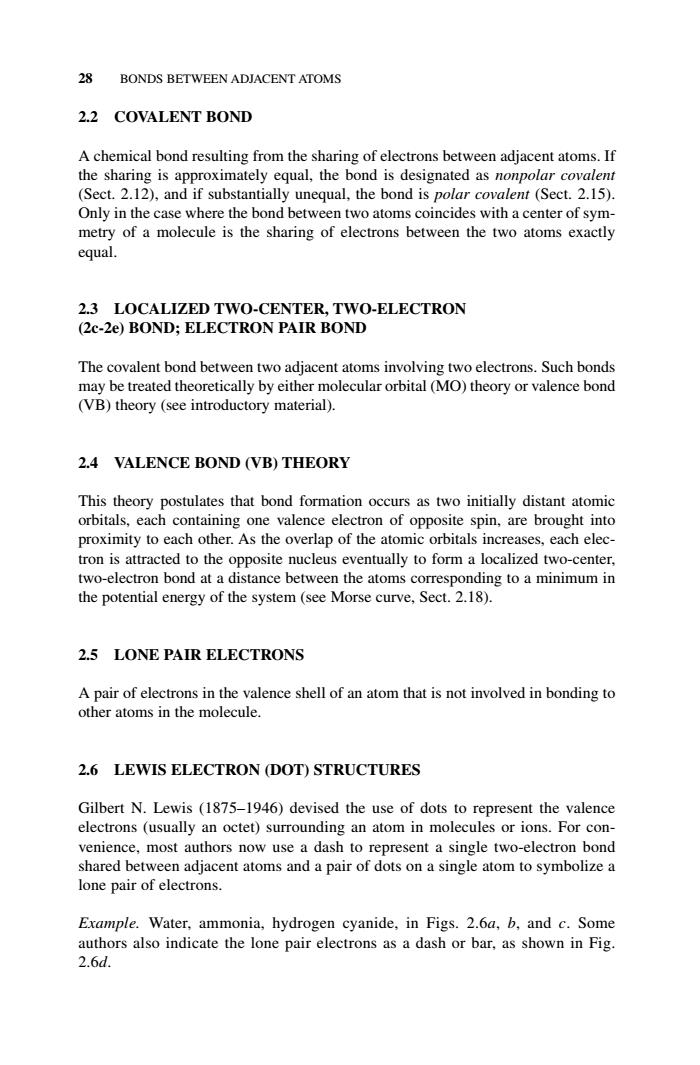正在加载图片...

28 BONDS BETWEEN ADJACENT ATOMS 2.2 COVALENT BOND A chemical bond resulting from the sharing of electrons between adjacent atoms.If the sharing is approximately equal,the bond is designated as nonpolar covalent (Sect.)and f substantally the bond is polr(Sect.25). Only in the case where the bond betw oincides with a c ter of syn metry of a molecule is the sharing of electrons between the two atoms exactly equal 2.3 LOCALIZED TWO-CENTER,TWO-ELECTRON (2c-2e)BOND;ELECTRON PAIR BOND The covalent bond between two adjacent atoms involving two electrons.Such bonds treated th nolecular orbital (MO) theory or valence bond 2.4 VALENCE BOND (VB)THEORY This theory postulates that bond formation occurs as two initially distant atomic orbitals,each containing one valence electron of opposite spin,are brought into mtto cch other As the overlap of the atomic or localized t ing to a minimum in the potential energy of the system(see Morse curve,Sect.2.18). 2.5 LONE PAIR ELECTRONS A pair of electrons in the valence shell of an atom that is not involved in bonding to other aton s in the molecule 2.6 LEWIS ELECTRON (DOT)STRUCTURES Gilbert N.Lewis (1875-1946)devised the use of dots to represent the valence electrons(usually an octet)surrounding an atom in molecules or ions.For con- venience,most authors now use a dash to represent a single two-electron bond shared betw een adjacent atoms and a pair of dots on a single atom to symbolize lone pair of electrons Example.Water,ammonia,hydrogen cyanide,in Figs.2.6a,b,and c.Some authors also indicate the lone pair electrons as a dash or bar,as shown in Fig. 2.6d. 2.2 COVALENT BOND A chemical bond resulting from the sharing of electrons between adjacent atoms. If the sharing is approximately equal, the bond is designated as nonpolar covalent (Sect. 2.12), and if substantially unequal, the bond is polar covalent (Sect. 2.15). Only in the case where the bond between two atoms coincides with a center of symmetry of a molecule is the sharing of electrons between the two atoms exactly equal. 2.3 LOCALIZED TWO-CENTER, TWO-ELECTRON (2c-2e) BOND; ELECTRON PAIR BOND The covalent bond between two adjacent atoms involving two electrons. Such bonds may be treated theoretically by either molecular orbital (MO) theory or valence bond (VB) theory (see introductory material). 2.4 VALENCE BOND (VB) THEORY This theory postulates that bond formation occurs as two initially distant atomic orbitals, each containing one valence electron of opposite spin, are brought into proximity to each other. As the overlap of the atomic orbitals increases, each electron is attracted to the opposite nucleus eventually to form a localized two-center, two-electron bond at a distance between the atoms corresponding to a minimum in the potential energy of the system (see Morse curve, Sect. 2.18). 2.5 LONE PAIR ELECTRONS A pair of electrons in the valence shell of an atom that is not involved in bonding to other atoms in the molecule. 2.6 LEWIS ELECTRON (DOT) STRUCTURES Gilbert N. Lewis (1875–1946) devised the use of dots to represent the valence electrons (usually an octet) surrounding an atom in molecules or ions. For convenience, most authors now use a dash to represent a single two-electron bond shared between adjacent atoms and a pair of dots on a single atom to symbolize a lone pair of electrons. Example. Water, ammonia, hydrogen cyanide, in Figs. 2.6a, b, and c. Some authors also indicate the lone pair electrons as a dash or bar, as shown in Fig. 2.6d. 28 BONDS BETWEEN ADJACENT ATOMS c02.qxd 5/17/2005 5:13 PM Page 28